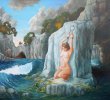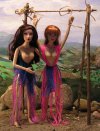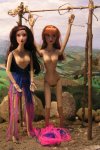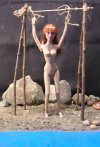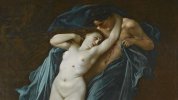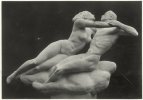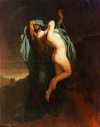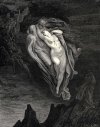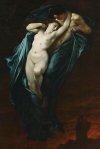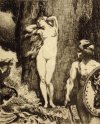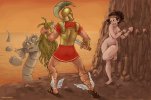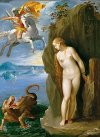Zephyros
Magistrate
Since boyhood Greek mythology has captured my imagination, the tale of valiant Perseus rescuing fair Andromeda bonded and shackled - a particular favorite.
In Greek mythology, Andromeda was the daughter of Cepheus and Cassiopeia, king and queen of the North African kingdom of Aethiopia.
Andromeda has been the subject of numerous ancient and modern works of art, which typically show the moment of rescue, with Andromeda usually still chained, and often naked or nearly so.
A bronze cista (box; first half of III B.C.E.) from Palestrina includes an image of Andromeda attached to a patibulum (horizontal bar) supported by two vertical stakes.

Andromeda exposed on a patibulum (Lafaye 1574)
On a vase dating from around 350 B.C.E., we find a tortured Greek god Prometheus chained in cruciform, while another vase dating to the late sixth to early seventh centuries B.C.E. depicts Prometheus on a stake or stauros, as the term is in Greek - the same word used in the New Testament to describe Christ's cross. Moreover, the mythical princess Andromeda was portrayed essentially as having been crucified, as demonstrated by an image from Pompeii, which was destroyed in 79 C.E, several centuries before Christ was depicted on the cross in art.

In the following, i present my favorite artworks, some well-known, some un-known ...
I start with the classics …








Note @ Pierre Mignard: Andromeda's parents thank Perseus for freeing her
And here some more background information... before continuing the pic gallery …(feel free to skip)
Prometheus, the god who defied Zeus and procured fire for mortals, was fastened to the Caucasian rock with nails and chains (or hoops of iron). This myth was immortalized in Aeschylus’ play, Prometheus Bound, and satirized in Lucian’s treatises, Zeus Catechized and Prometheus. But a similar tale was told about a feminine figure, the Princess Andromeda.
But the maiden fastened to a rock like Prometheus (in some accounts "crucified") appears to have been of some interest in the ancient world. Euripides wrote a play called Andromeda, which seems to have influenced Aristophanes in the Thesmophoriazusae, a work which centers on women celebrating the festivals of Demeter and Persephone, the givers and guardians of the home. The women wish to put Euripides on trial for his scathing remarks about women, and Euripides persuades his friend, Mnesilochus, to dress up as a woman and defend him. However, the ruse is discovered and Mnesilochus suffers the fate of apotimpanismos, although he is rescued in time and does not die.
But the play makes obvious references to Andromeda, so that Mnesilochus’s sufferings are but an echo of hers. Thus Andromeda may have been to women what Prometheus was to men. Both are crucified mythical figures who brought blessings to humankind. Andromeda is not a goddess, but her „exaltation” to the heavens is referred to in Manilius’ Astronomica. He sees Andromeda in the zodiacal sign of Virgo.
There follows the constellation of Andromeda, whose golden light appears in the rightward sky when the Fishes have risen to twelve degrees. Once upon a time the sin of cruel parents caused her to be given up for sacrifice (quondam poenae dirorum culpa parentun/prodidit) when a hostile sea in all its strength burst upon every shore, the land was shipwrecked in the flood, and what had been a king’s domain was now an ocean. From those ills but one price of redemption was proposed, surrender of Andromeda to the raging main for a monster to devour her tender limbs. This was her bridal; eliving the people’s hurt by submitting to her own, she is tearfully adorned as victim for the avenging beast and dons attire prepared for no such troth as this .... Then as soon as the procession reaches the shore of the tumultuous sea, her soft arms are stretched out on the hard rocks ; they bound her feet to crags and cast chains upon her; and there to die on her virgin cross the maiden hung. Even in the hour of sacrifice she yet preserves a modest demeanor: her very sufferings become her, for, gently inclining her snow - white neck, she seemed to have full charge of her pose. The folds of her robe slipped from her shoulders and fell from her arms, and her streaming locks covered her body (Astronomica 5.538 557).
Manilius describes how nature emphathized with her, even the breeze (ipsa levi flatu refovens pendentia membra). Perseus arrives and calls the chains happy to „clasp such limbs”. So he won a place in heaven for Andromeda. Noticeable in the Manilius passage are the ideas of vicarious sacrifice, propitiation of the gods and goddesses, and the details referring to apotimpanismos and crucifixion.
Another interesting reference to Andromeda occurs in Achilles Tatius. The Adventure of Leucippus and Clitophon. He describes a sculpture erected in Pelusium. It was a double picture painted by Evanthes, portraying both Andromeda and Prometheus. They were both in chains and secured to a rock and both were being tortured by monsters, Andromeda by the sea beast and Prometheus by the bird; they both had deliverers, Perseus for Andromeda, Hercules for Prometheus. Both deliverers were Argives (6.3 - 4).
Andromeda rests in a hollow in the rock. She wears a look of both fear and beauty even though her arms are pinioned above her head. Evanthes had depicted the beast just rising out of the water and Perseus descending to help the maiden. Achilles Tatius tells us that rocks and iron formed the bonds of Prometheus. He is writhing in agony but, like Andromeda, wears a look of both fear and hope.
Evanthes’ sculpture would suggest that some people saw Andromeda as a parallel to Prometheus. This material is complex but it does suggest an apostrophic and sacrificial approach to the crucifixion of a woman, albeit one found in myth rather than history.
In Greek mythology, Andromeda was the daughter of Cepheus and Cassiopeia, king and queen of the North African kingdom of Aethiopia.
Andromeda has been the subject of numerous ancient and modern works of art, which typically show the moment of rescue, with Andromeda usually still chained, and often naked or nearly so.
A bronze cista (box; first half of III B.C.E.) from Palestrina includes an image of Andromeda attached to a patibulum (horizontal bar) supported by two vertical stakes.

Andromeda exposed on a patibulum (Lafaye 1574)
On a vase dating from around 350 B.C.E., we find a tortured Greek god Prometheus chained in cruciform, while another vase dating to the late sixth to early seventh centuries B.C.E. depicts Prometheus on a stake or stauros, as the term is in Greek - the same word used in the New Testament to describe Christ's cross. Moreover, the mythical princess Andromeda was portrayed essentially as having been crucified, as demonstrated by an image from Pompeii, which was destroyed in 79 C.E, several centuries before Christ was depicted on the cross in art.

In the following, i present my favorite artworks, some well-known, some un-known ...
I start with the classics …







Note @ Pierre Mignard: Andromeda's parents thank Perseus for freeing her
And here some more background information... before continuing the pic gallery …(feel free to skip)
Prometheus, the god who defied Zeus and procured fire for mortals, was fastened to the Caucasian rock with nails and chains (or hoops of iron). This myth was immortalized in Aeschylus’ play, Prometheus Bound, and satirized in Lucian’s treatises, Zeus Catechized and Prometheus. But a similar tale was told about a feminine figure, the Princess Andromeda.
But the maiden fastened to a rock like Prometheus (in some accounts "crucified") appears to have been of some interest in the ancient world. Euripides wrote a play called Andromeda, which seems to have influenced Aristophanes in the Thesmophoriazusae, a work which centers on women celebrating the festivals of Demeter and Persephone, the givers and guardians of the home. The women wish to put Euripides on trial for his scathing remarks about women, and Euripides persuades his friend, Mnesilochus, to dress up as a woman and defend him. However, the ruse is discovered and Mnesilochus suffers the fate of apotimpanismos, although he is rescued in time and does not die.
But the play makes obvious references to Andromeda, so that Mnesilochus’s sufferings are but an echo of hers. Thus Andromeda may have been to women what Prometheus was to men. Both are crucified mythical figures who brought blessings to humankind. Andromeda is not a goddess, but her „exaltation” to the heavens is referred to in Manilius’ Astronomica. He sees Andromeda in the zodiacal sign of Virgo.
There follows the constellation of Andromeda, whose golden light appears in the rightward sky when the Fishes have risen to twelve degrees. Once upon a time the sin of cruel parents caused her to be given up for sacrifice (quondam poenae dirorum culpa parentun/prodidit) when a hostile sea in all its strength burst upon every shore, the land was shipwrecked in the flood, and what had been a king’s domain was now an ocean. From those ills but one price of redemption was proposed, surrender of Andromeda to the raging main for a monster to devour her tender limbs. This was her bridal; eliving the people’s hurt by submitting to her own, she is tearfully adorned as victim for the avenging beast and dons attire prepared for no such troth as this .... Then as soon as the procession reaches the shore of the tumultuous sea, her soft arms are stretched out on the hard rocks ; they bound her feet to crags and cast chains upon her; and there to die on her virgin cross the maiden hung. Even in the hour of sacrifice she yet preserves a modest demeanor: her very sufferings become her, for, gently inclining her snow - white neck, she seemed to have full charge of her pose. The folds of her robe slipped from her shoulders and fell from her arms, and her streaming locks covered her body (Astronomica 5.538 557).
Manilius describes how nature emphathized with her, even the breeze (ipsa levi flatu refovens pendentia membra). Perseus arrives and calls the chains happy to „clasp such limbs”. So he won a place in heaven for Andromeda. Noticeable in the Manilius passage are the ideas of vicarious sacrifice, propitiation of the gods and goddesses, and the details referring to apotimpanismos and crucifixion.
Another interesting reference to Andromeda occurs in Achilles Tatius. The Adventure of Leucippus and Clitophon. He describes a sculpture erected in Pelusium. It was a double picture painted by Evanthes, portraying both Andromeda and Prometheus. They were both in chains and secured to a rock and both were being tortured by monsters, Andromeda by the sea beast and Prometheus by the bird; they both had deliverers, Perseus for Andromeda, Hercules for Prometheus. Both deliverers were Argives (6.3 - 4).
Andromeda rests in a hollow in the rock. She wears a look of both fear and beauty even though her arms are pinioned above her head. Evanthes had depicted the beast just rising out of the water and Perseus descending to help the maiden. Achilles Tatius tells us that rocks and iron formed the bonds of Prometheus. He is writhing in agony but, like Andromeda, wears a look of both fear and hope.
Evanthes’ sculpture would suggest that some people saw Andromeda as a parallel to Prometheus. This material is complex but it does suggest an apostrophic and sacrificial approach to the crucifixion of a woman, albeit one found in myth rather than history.




























